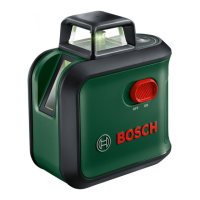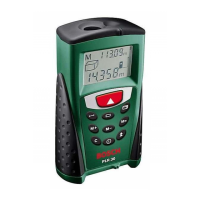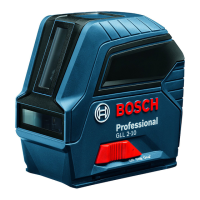20 | English
Close the battery compartment before using the measuring tool.
If the battery is running low, the light-up ring(3) will flash yellow three times after the
tool is switched on. The measuring tool can be operated for approx. another 15min.
u Take the battery out of the measuring tool if you do not intend to use the tool for
a long time. When it is stored in the measuring tool for longer periods, the battery can
corrode and discharge itself.
Attaching the Measuring Tool
Selecting/changing the pad
The measuring tool can be attached to walls or other vertical surfaces. Depending on the
type of substrate, either the gel pad(14) including the gel pad holder(13) or the pin
pad(7) with 2 pins(8) can be used.
As a general rule: The gel pad(14) is suitable for smooth surfaces. The pin pad(7) is
suitable for coarse or rough surfaces and wallpaper on drywalls. The pin pad cannot be
attached to concrete (regardless of the surface).
Substrate for attaching with the
Gel pad Pin pad
(Ceramic) tiles Wallpaper (woodchip, paper and fleece)
Smooth wooden surfaces Plastered surfaces (up to a roughness of
around 2mm)
Natural stone, marble, concrete
Gloss-coated surfaces (depending on the
age and condition of the substrate)
To change the gel pad, turn the gel pad holder(13) anticlockwise and take the gel
pad(14) and holder off the measuring tool. Attach the pin pad(7) and turn it clockwise
as far as it will go. The same procedure should also be followed when switching from the
pin pad to the gel pad.
Attaching with the gel pad
Requirements:
The substrate must be dry and firm.
The gel pad is not guaranteed to stick to damp, particularly dusty, sharp-edged or highly
textured surfaces. If attached to unsuitable surfaces such as these, the measuring tool
can fall off and become damaged or damage the substrate.
If the gel pad becomes dirty or does not stick to smooth surfaces any more, it must be
cleaned or replaced (see "Cleaning the Gel Pad", page25).
1 609 92A 55E | (12.05.2020) Bosch Power Tools

